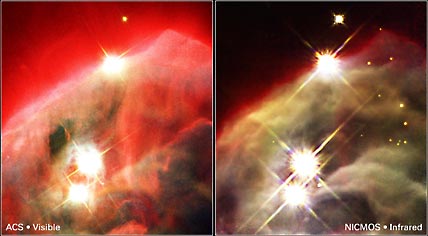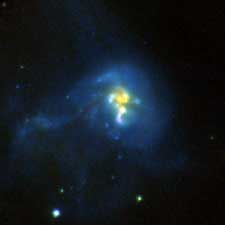
A small scene in the tip of the Cone Nebula captured in visible light with Hubble's new ACS camera (left) and in near-infrared with Hubble's revived NICMOS camera (right). The frames are 50 arcseconds tall. Click for larger view.
Courtesy NASA.
When astronauts repaired and upgraded the Hubble Space Telescope last March, their most publicized task was installing Hubble's supersensitive new Advanced Camera for Surveys (ACS). It soon began taking stunning deep, wide-field images to the delight of NASA engineers and the whole astronomical world. But the tool-wielding astronauts also brought to life a different instrument: NICMOS, the Near-Infrared Camera and Multi-Object Spectrometer. Today NASA held a press conference to show off this overshadowed sibling instrument.
Shown above is a comparison of ACS (visible-light) and NICMOS (near-infrared) views of the tip of the Cone Nebula in Monoceros. Both images have similarly sharp resolution, better than 0.1 arcsecond. However, NICMOS's infrared view penetrates into the gassy dust pillar to reveal faint stars that are embedded within it — or perhaps that are shining all the way through from the background.

This NICMOS view of IRAS 19297-0406 shows a galactic demolition derby with four galaxies colliding at once. The result is a flood of new stars.
Courtesy NASA and the NICMOS Team (STScI, ESA, University of Arizona)
NICMOS was installed on Hubble in February 1997, but, disappointingly, ran out of coolant after just 23 months. A sensitive infrared camera needs to stay chilled to cryogenic temperatures to keep from being blinded by its own infrared glow. The March repair added a small cryogenic refrigerator that can keep the NICMOS detector chilled indefinitely to 77° Kelvin
(–321° Fahrenheit), with no additional coolant required.
Moreover, because the temperature can now be carefully tuned, NICMOS is "30 to 40 percent more sensitive than it was in the past," said Daniela Calzetti (Space Telescope Science Institute) at the press conference.
The three cameras of the NICMOS instrument have much narrower fields than ACS, however. ACS gives picture-window views 200 arcseconds square, while frames from the three NICMOS cameras are 11, 17, and 51 arcseconds square.
Additional new NICMOS images and information are on NASA's press site.
 0
0
Comments
You must be logged in to post a comment.